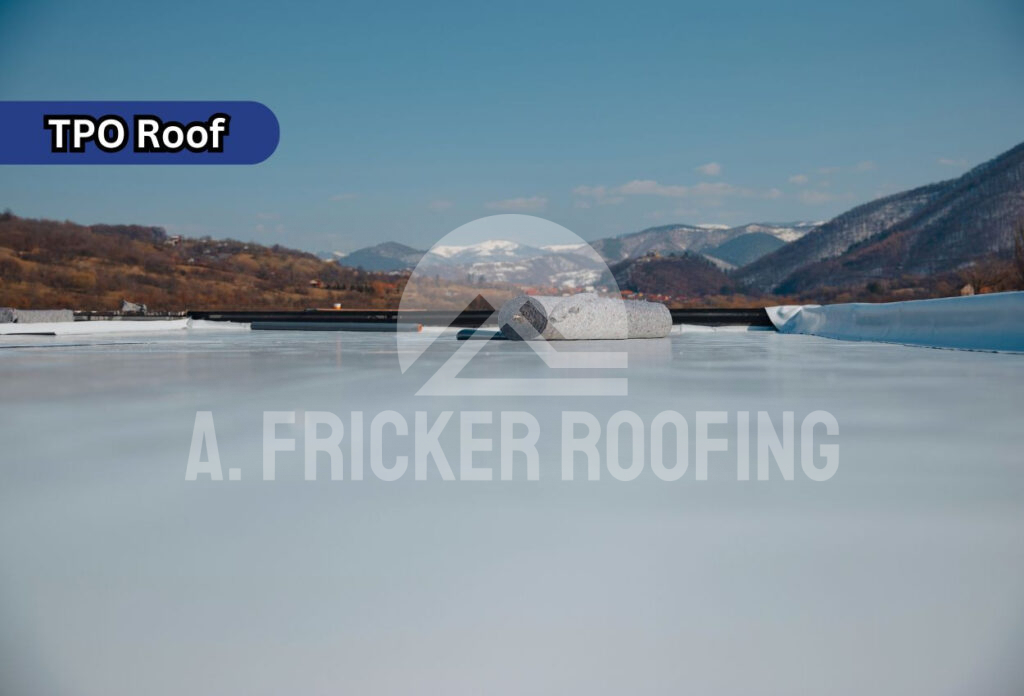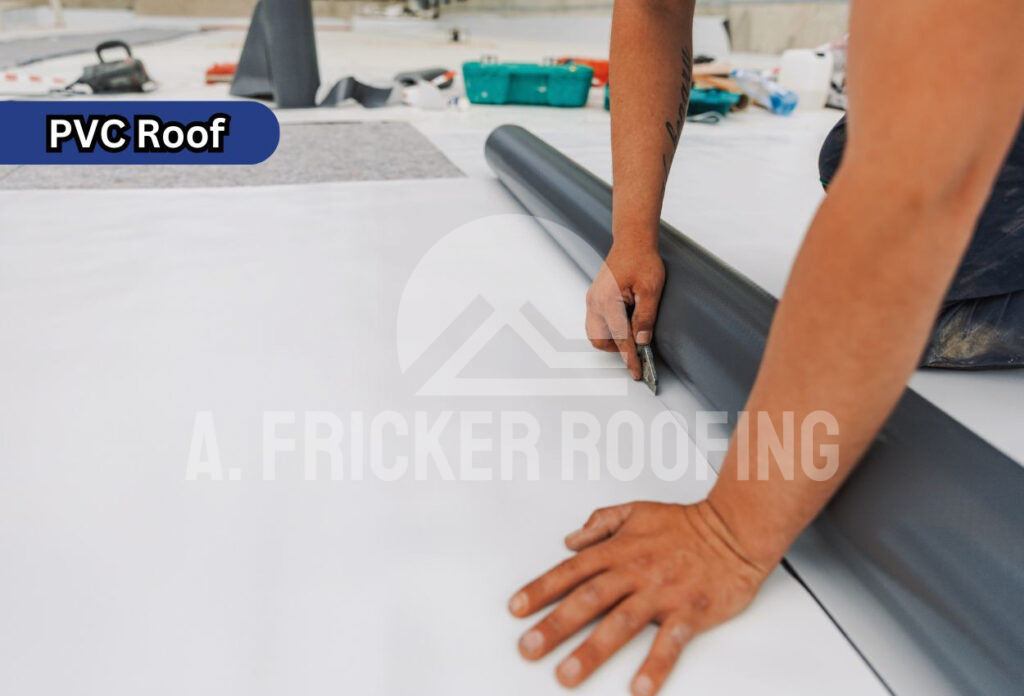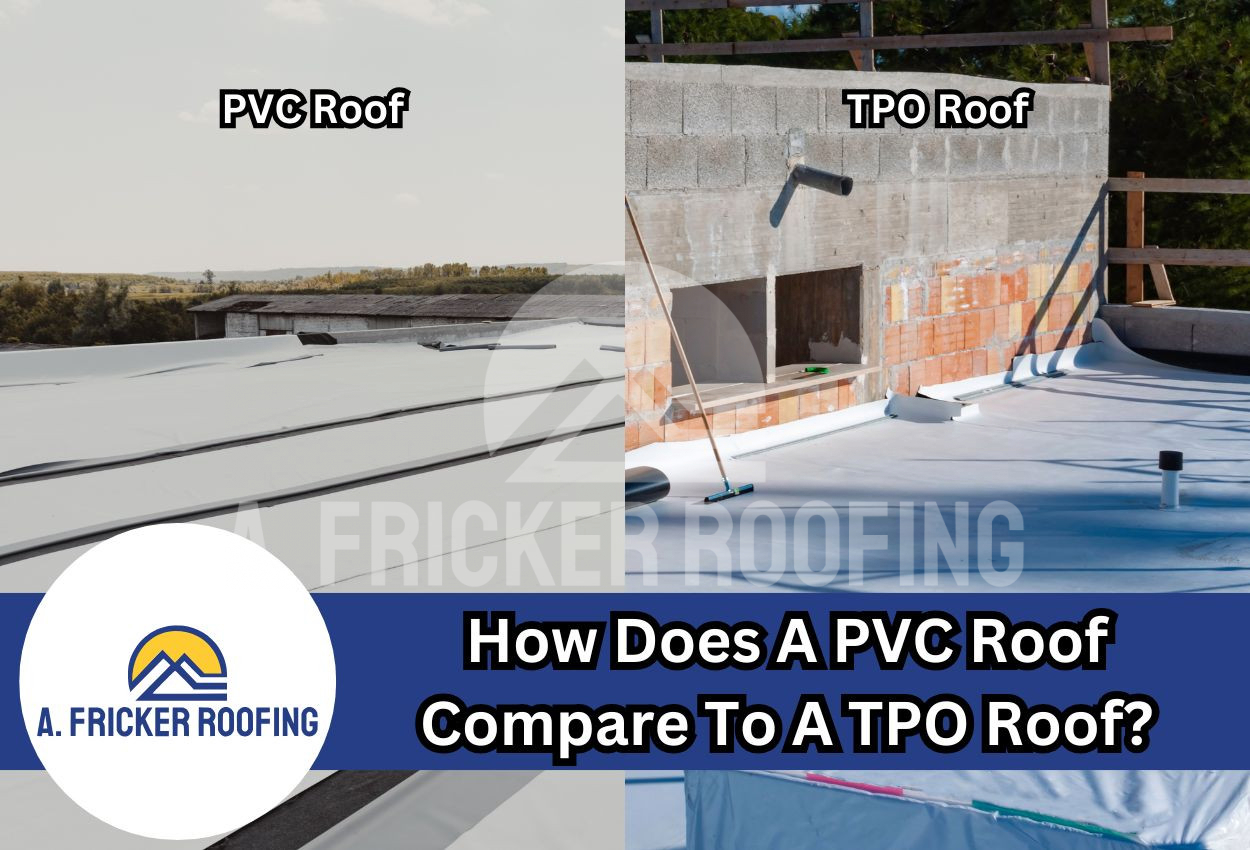When it comes to choosing a roofing material for your home or building, you’ve probably come across terms like PVC and TPO. Both are great flat roofing options commonly used for residential and commercial buildings, but knowing how they stack up against each other can make all the difference in your decision making.
We’re here to make the choice easier for you. By the end of this guide, you’ll know what makes PVC and TPO unique, how they compare, and which one might be the better fit for your property. Let’s break it down step by step, without the technical jargon.
What Is A TPO Roof?

TPO, or thermoplastic polyolefin, is a top-quality single-ply roofing membrane. Out of the three popular single-ply membranes (TPO, EPDM, and PVC), TPO is the most recent (being relatively newer than both PVC and EPDM). TPO is made from a blend of rubber, polypropylene, and other materials to create a strong, flexible, and energy-efficient roofing solution.
It’s especially popular for its strength and eco-friendly properties, making it a go-to option for business owners who want something cost-effective but high-performing for their commercial properties.
Pros of TPO Roofs
- Budget-friendly and cost-effective.
- Excellent energy efficiency with high UV reflectivity.
- Lightweight and easy to install.
- Environmentally friendly and recyclable.
Cons of TPO Roofs
- Slightly shorter lifespan (15 to 20 years).
- Variations in material quality between manufacturers.
What are PVC Roofs?

PVC stands for polyvinyl chloride. It’s a type of plastic that’s been used for roofing for decades. PVC roofs are made up of two layers of PVC material, reinforced with a polyester scrim (a kind of fabric) in the middle. The result is a durable, flexible, and weather-resistant roofing membrane.
One standout feature? PVC is great at resisting chemicals, grease, and fire, which is why it’s a favorite for restaurants and industrial buildings—but it’s also gaining popularity for homes with flat roofs.
Pros of PVC Roofs
- Highly durable and long-lasting with a lifespan of 20 to 30 years.
- Excellent chemical and fire resistance.
- Strong against extreme weather conditions.
- Requires minimal maintenance.
Cons of PVC Roofs
- Higher upfront cost compared to TPO.
- Less environmentally friendly due to its manufacturing process.
TPO vs. PVC: Key Differences
TPO and PVC might seem similar at first glance. They are made of similar components and both usually have a bright white color. However, there are several differences between TPO and PVC. Knowing these can help you choose the material that fits your property better.
Here are some things to consider:
Durability: Which One Lasts Longer?
Let’s be real—your roof is an investment, and you want it to last. So how do PVC and TPO compare in terms of durability?
TPO: TPO roofs have come a long way and are designed to be tough. However, because it’s newer to the market, there’s a bit more variability in how long it lasts. Like PVC, TPO roofing membrane is also Class A fire resistant. However, its chemical resistance is not as good.
Generally, a TPO roof will last around 15 to 20 years, though higher-quality TPO membranes might edge closer to PVC’s longevity.
To know more about TPO’s lifespan, read our blog post: How Long Does A TPO Roof Last?
PVC: This material is a champ when it comes to standing up to the elements. PVC roofing membranes are highly resistant to punctures, chemicals, and UV radiation. In fact, it can last up to 20 to 30 years with proper maintenance. The material is also naturally fire-resistant, adding another layer of protection.
Energy Efficiency: Keeping Your Building Cool
Energy efficiency isn’t just a nice bonus; it can make a big difference in your utility bills. Let’s see how PVC and TPO perform here.
TPO: This is where TPO shines. TPO roofs are designed to reflect UV rays and heat, making them incredibly energy-efficient. Many TPO membranes are Energy Star-rated, which means they meet strict guidelines for heat reflection and insulation.
PVC: PVC roofing membranes typically come in lighter colors, which naturally reflect sunlight and reduce heat absorption. While it’s not quite as efficient as TPO, it still does a good job of keeping your home or building cool, especially if you choose a white or light-colored membrane.
Cost Considerations: Is PVC More Expensive Than TPO?
We know cost plays a huge role in deciding on a roofing material. This is why it is important to know how much will it cost to install a single-ply membrane roofing system. Let’s start with TPO.
TPO: A TPO roofing membrane is more budget-friendly than a PVC roof. On average, TPO roofs cost around $5 to $10 per square foot. This variance is due to several factors such as the size of your roof and the TPO roofing manufacturer.
It provides great performance for the price, making it a popular choice for home and business owners who want a reliable roof without breaking the bank.
PVC: While PVC roofing membranes offer excellent durability and performance, they tend to be more expensive than TPO. The cost of a PVC roof can be anywhere around $7 to $13 per square foot. The upfront cost is higher, but PVC roofs often last longer and require fewer repairs compared to TPO.
Weather Resistance: Which Single Ply Membrane Can Handle Oklahoma’s Weather?
In Oklahoma, your roof must withstand diverse weather conditions, from high temperatures to freezing temperatures.
TPO: This roofing material performs reliably in most weather conditions, offering flexibility that allows expansion and contraction with temperature changes. TPO is generally suitable for standard residential or commercial environments with moderate climate challenges.
PVC: PVC roofs have superior resistance to extreme weather conditions, including heavy rain and strong winds. Its chemical resistance makes it particularly effective in areas exposed to pollutants or challenging environmental factors.
Environmental Impact: Going Green
For business owners, sustainability and energy efficiency aren’t just trends—they’re essential factors for reducing operational costs and supporting eco-friendly initiatives. Here’s how PVC and TPO roofing systems perform when it comes to their environmental impact.
TPO: TPO is often seen as the greener choice. It is fully recyclable, free of chlorine, and manufactured with fewer harmful emissions, making it a safer option for businesses aiming to meet sustainability goals. Its excellent UV reflectivity further boosts energy efficiency, reducing cooling costs.
PVC: PVC is recyclable at the end of its lifespan, with industry programs actively reclaiming old membranes to produce new materials like walkway pads and flooring. However, its production process involves chlorine, which can lead to harmful emissions. Additionally, PVC can release toxic substances if burned, raising concerns for businesses focused on going green.
Installation: Which One’s Easier To Install?
The installation process can affect both the cost and the quality of your roof.
TPO: TPO gives you installation flexibility. It is heat-welded at the seams, but the process is often a bit simpler and faster compared to PVC. This can sometimes result in slightly lower labor costs.
PVC: PVC also has a straightforward installation process; however, when compared to TPO, it is slightly complex. PVC is also heat-welded at the seams to create a watertight seal. However, the size of the rolls is slightly smaller and the welding needs more attention. This means you’ll need to work with an experienced roofing company to ensure everything is secure.
Final Thoughts: Which One Should You Choose?
Here’s the bottom line: both PVC and TPO roofs have their strengths and can serve specific needs for flat or low-slope roofing systems. However, if you’re looking for a solution for most standard business applications, TPO takes the lead.
PVC is a good option when you are dealing with unique challenges like exposure to grease, oil, or harsh chemicals—conditions commonly found in restaurants or industrial facilities. PVC’s chemical resistance and long-term durability make it a strong contender in these specialized cases.
For the majority of other businesses, TPO is the better all-around choice. It’s budget-friendly, highly energy-efficient, and environmentally conscious.
Your Trusted TPO Roof Installers In Oklahoma
If you are looking to install a new TPO roof, look no further than A. Fricker Roofing and Waterproofing. We have an experienced team of roofers, and we work with the best manufacturers.
If you’re still not sure which roofing material is right for your home or commercial roof, feel free to give us a call at (918) 402-7167. Our team is here to help you weigh the pros and cons and find the perfect roofing solution.

